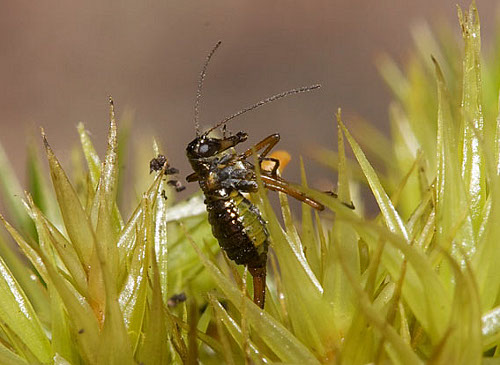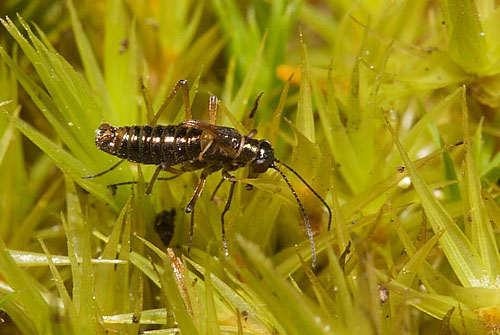
©Rosemary Winnall
Worcestershire Record No. 28. April 2010

|
| Picture: Snow flea Boreus hyemalis female on moss, Wyre Forest. ©Rosemary Winnall |
P. F. Whitehead
Moor Leys, Little Comberton, Pershore, Worcestershire WR10 3EH
A glance at Plant (1994) or the current National Biodiversity Network (http://data.nbn.org.uk) distribution map will suggest that the so-called Snow Flea Boreus hyemalis (L., 1767) (Mecoptera: Boreidae) is absent from Worcestershire. Why that should be is not clear; I certainly submitted records for Colin Plant's atlas.
The Snow Flea is a fascinating insect and a cold-climate relict. Boreus is also an interesting genus, the males having reduced wings and the females none, so that their dispersal ability is clearly limited, and British populations are largely but by no means exclusively upland. They are one of the few larger insects active in winter and can be observed crawling on snow beds in temperatures around freezing point. Boreus is a cold stenothermic genus, adults becoming enfeebled at temperatures exceeding 17oC or so. Without close scrutiny Boreus could be mistaken for a depauperate tipulid or a wingless Scorpion Fly Panorpa. In fact the occasionally-employed name, Snow Scorpionfly, is more apt. Adult females are about five millimetres in length and are largely dark in colour apart from the orange legs, paler rostra, and pale orange apical abdominal segments.
 |
| Snow flea Boreus hyemalis male on moss, Wyre Forest. ©Rosemary Winnall |
The larval affinity is with exposed or broken colline to montane grassland with abundant mosses, especially Polytrichum, amongst which the larvae live, apparently feeding on the moss itself. I have only ever encountered B. hyemalis in Worcestershire on the Malvern Hills and then rarely and most recently on 13th November 1988 at Swinyard Hill (SO7638 240m O.D.). It seems that B. hyemalis is a truly localised species in Worcestershire but one that is likely to occur more widely on the Malvern Hills. B. hyemalis is tolerably widespread, but some species, such as Boreus lokayi Klapalek, 1901, occur in the mountains of Central Europe and south-east Central Europe, and are prime risk candidates for climatic warming impacts.
Reference
PLANT, C.W. 1994. Provisional atlas of the lacewings and allied insects (Neuroptera, Megaloptera, Raphidioptera and Mecoptera) of Britain and Ireland, edited for the Biological Records Centre by P.T. Harding, B.C. Eversham and H.R. Arnold. Huntingdon: Biological Records Centre.
On 2nd December 2009 several naturalists on a foray in search of bryophytes in Wyre Forest happened to find both male and female Snow Fleas on a moss clump (Winnall 2009). Sadly, the site in Withybeds Wood is on the north side of the Dowles Brook so is actually in Shropshire so Worcestershire cannot claim the record, although the species probably occurs throughout the Forest in suitable locations. Mark Lawley identified the moss as Dicranum scoparium. Rosemary Winnall obtained photographs which happily illustrate Paul Whitehead’s article. The snow must have stimulated national interest in the species as photographs appeared in the BBC Wildlife Magazine along with other invertebrates which can be seen on snow, and further information can be found on the Buglife web site http://www.buglife.org.uk/discoverbugs/bugofthemonth/snowflea. A challenge for next winter is to obtain records in Worcestershire.
Reference
WINNALL R. 2009. Snow Flea Boreus hyemalis (L., 1767) (Mecoptera: Boreidae). Wyre Forest Study Group Review 2009. 10:42.